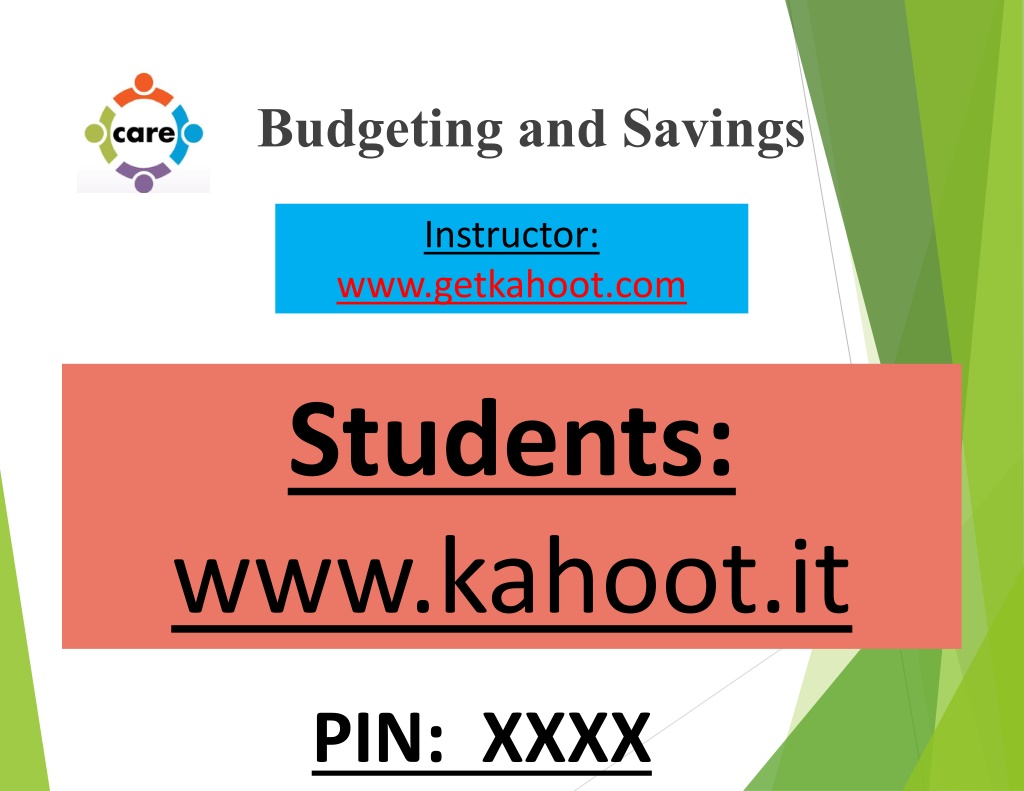Effective Budgeting and Savings Strategies for Students and Young Adults
Explore the importance of budgeting, tracking expenses, distinguishing between needs and wants, and understanding inflows and outflows in a budget to achieve financial goals, gain financial freedom, and reduce stress. Start your journey towards responsible financial management today!
Download Presentation

Please find below an Image/Link to download the presentation.
The content on the website is provided AS IS for your information and personal use only. It may not be sold, licensed, or shared on other websites without obtaining consent from the author. Download presentation by click this link. If you encounter any issues during the download, it is possible that the publisher has removed the file from their server.
E N D
Presentation Transcript
Budgeting and Savings Instructor: www.getkahoot.com Students: www.kahoot.it PIN: XXXX
Budgeting and Savings A financial literacy program for students and young adults
A Budget is a written record of the money that flows in and out of your household (or pocket) each month
Why Budget? Achieve Financial Goals More Financial Freedom Avoid costly borrowing Reduce Stress
How Do You Start? Write down all the money that comes in and EVERYTHING you spend money on
Creating a Budget Track your expenses How much do you have to spend? How much do you REALLY spend? Things you spend on that aren t necessary?
Know the Difference between Needs and Wants Needs (Essential Expenses) Expenses you need to live Wants(NON-Essential Expenses) Expenses you DO NOT need to live
TRUE or FALSE A budget is a written record of the money you have coming in (called an "inflow") and going out (called an "outflow")
TRUE A budget is a written record of the money you have coming in (called an "inflow") and going out (called an "outflow")
What are the inflows and outflows of a budget called?
What are the inflows and outflows of a budget called? Income (Inflows) Expenses (Outflows)
Which refer to a NEED? a. Not necessary b. Something you really want c. Absolutely required to live d. Something you can live without
Which of these is a NEED? a. Not necessary b. Something you really want c. Absolutely required to live d. Something you can live without
How do you start tracking expenses? a. Review bank statements b. Log expenses regularly c. Use MINT and online services d. All of the above
How do you start tracking expenses? a. Review bank statements b. Log expenses regularly c. Use MINT and online services d. All of the above
Lets: 1. create a budget and 2. label the expenses as needs and wants.
There are TWO Types of Expenses FIXED Expenses vs. Variable Expenses
Needed (Essential) FIXED Expenses Rent or Mortgage Insurance (auto or home) Car Payments Taxes School Loans Other debt (including credit cards)
Needed (Essential) VARIABLE Expenses Car Maintenance Utilities (Gas, Electric, Water, Garbage) Food Phone Medical/Rx
Wants (NON- Essential) Expenses Non-Essential Clothing Pets Gym Entertainment Video/Media Other items you want but don t need
Balancing Income and Expenses At the end of the month, is Income > Expenses? (Do you have money left over?) Yes! Great, you can save what s left over! NO! There s a problem! *Spend Less Than You Make!
An Unbalanced Budget Brings Trouble Income < Expenses Not saving Borrow Money = costly Not pay people you owe Income = Expenses Not saving Avoid borrowing costs
Are Expenses too High for your Income? What can you cut out? Determine how much you should save
What expenses are easy to predict? a. Fixed Expenses b. Variable Expenses c. Both
What expenses are easy to predict? a. Fixed Expenses b. Variable Expenses c. Both
In what situations can you start saving? a. Income = Expenses b. Income > Expenses c. Income < Expenses d. All of the above
In what situations can you start saving? a. Income = Expenses b. Income > Expenses c. Income < Expenses d. All of the above
What changes help saving? a. Increase Income b. Decrease Income c. Increase Expenses d. Decrease Expenses
What changes help saving? GOAL: Income > Expenses a. Increase Income b. Decrease Income c. Increase Expenses d. Decrease Expenses
How to Save Pay yourself first by setting aside money from every paycheck Automatic withdrawals from your paycheck Easy Effective
Financial Goals (Identify and Write Down) Vacation and travel College Downpayment for car Downpayment for a house Avoid Debt Pay off credit card debt Pay off student loans
Different Types of Financial Goals Short-Term Medium-Term Long-Term
The Tricks to Setting Financial Goals Specific Realistic Written Down
Setting Goals Takes MATH Goal: Buy $1,000 Computer in 12 months Solution: $1,000/12 = $83 Is saving $83/month REALISTIC? * Calculating interest on borrowed money is more complex and requires more money
Where to Put Your Savings Short Term (cash to spend) Bank account E-pay account Medium-Term Goals (cash to buy) Interest-paying bank account Long-Term Goals (retirement) Retirement Plan Investment account
What are some characteristics of effective goals? a. Specific b. Realistic c. Written Down d. All of the above
What are some characteristics of effective goals? a. Specific b. Realistic c. Written Down d. All of the above
Why Budget? Achieve Financial Goals More Financial Freedom Avoid costly borrowing Reduce Stress




























